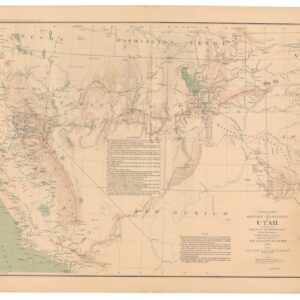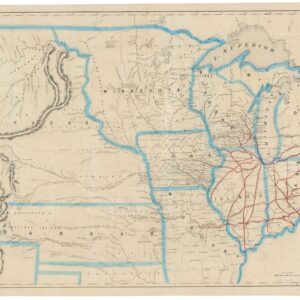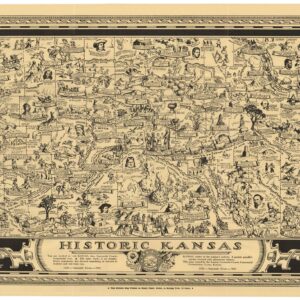A wonderful 1899 panoramic bird’s-eye-view of the route of the Mormon pioneers.
Route of the Mormon Pioneers from Nauvoo to Great Salt Lake [Issued by the New Wilson European Hotel, Salt Lake City]
$775
In stock
Description
This evocative 1899 pamphlet chronicles the 1300-mile journey of the Mormons from Nauvoo, on the Mississippi River, across the Great Plains and Rocky Mountains to the Great Salt Lake. Filled with images and pictorial vignettes that depict the notable features of the route, the story told by the print manipulates scale in order to emphasize the dramatic aspects of the trek — for example, the crossing of the Great Plains occupies only a small portion on the right of the map.
The route taken by Brigham Young’s party is marked, with each day’s camp indicated. Flanking the route itself are tiny profile views of Chimney Rock, Fort Laramie, Devil’s Gate, Giant Butte, Pulpit Rock and numerous other features of the trail west. Along the bottom of the print is a set of much larger images of scenes and scenery of the journey, including the wagon train crossing a river, a native American village, and the scenery of the Rockies. The print’s narration is said to have been derived from the journals of Orson Pratt and his brother Parley P. Pratt, original members of the “Quorum of Twelve Apostles.”
Cartographer(s):
Ermete Pierotti (1820-1880) was the oldest of nine siblings in a family from Pontardeto in Pieve Fosciana (the family built the Palazzo Pierotti, which has served as the town hall since 1877). Pierotti worked as a military engineer in Genoa and later served as a captain in the Engineering Corps of the Sardinian King. In 1849, he was accused of desertion and the theft of 3596 lire from the troop’s treasury, which resulted in a dishonorable discharge from the army. Pierotti then traveled to Jerusalem and Egypt, where he worked as an engineer. In Egypt, he discovered the foundations of the Alexandria Library while laying the foundations for a Greek church, but it was in Jerusalem that he would put his surveying and engineering skills to work.
Pierotti arrived in Jerusalem in 1854 as a consultant for the Franciscan Order, which had custody of many of the Christian holy sites in the city. During his time there, Pierotti was involved in the restoration of the Crusader Era Church of St. Anne, located in the Old City near the Pool of Bethesda. Working with Ottoman engineer Assad Effendi, he later contributed to the restoration of the Qanat as-Sabil, the main aqueduct that supplied Jerusalem with water, which involved repairing the aqueduct’s channels and cisterns. Other building projects included work on the Temple Mount itself and the construction of both the Austrian Hospice and the so-called Alexanderhof (HQ of the Kaiserlichen Orthodoxen Palästina-Gesellschaft) in the Christian Quarter of the Old City. And finally, he helped design the road from Jaffa to Jerusalem, a significant engineering feat at the time.
Pierotti became interested in the city’s history and archeology during his time in Jerusalem. He conducted several excavations in the Old City. He discovered several important artifacts, including an inscription in the Church of the Holy Sepulchre that proved the existence of a church on the site during the Byzantine period. Pierotti’s work in Jerusalem earned him a reputation as a skilled engineer and pioneering archeologist. He became known for his attention to detail and ability to work under challenging conditions. In addition to his many projects, Pierotti’s legacy consists of publishing his magnum opus: Jerusalem Explored. A Description of the Ancient and Modern City (1864), which included an entire volume of lithographed plates based on Pierotti’s plans and converted photographs.
Despite his many successes, Pierotti’s work and position annoyed the British, who increasingly sought to establish a scientific presence in the Holy City, if not a colonial one. When competition arose between Pierotti and Captain Charles Wilson’s team of English Royal Engineers conducting the first Ordnance Survey of Jerusalem and surroundings in 1864, Pierotti’s reputation was deliberately tarnished by the disclosure of his criminal past, and for the rest of his life, he struggled to regain recognition for his achievements.
Condition Description
Various blemishes. Professionally restored.
References



